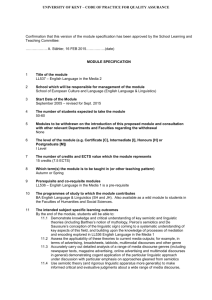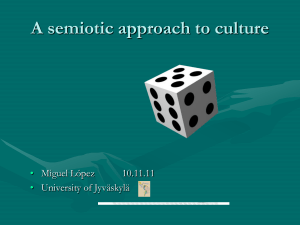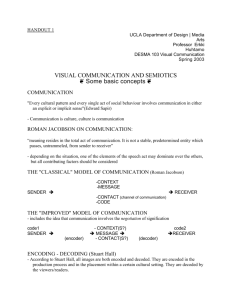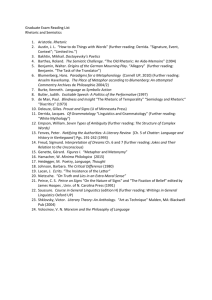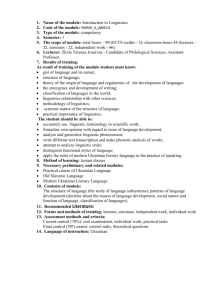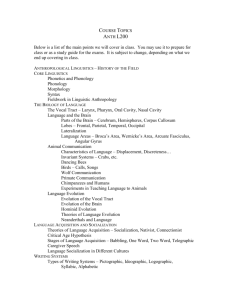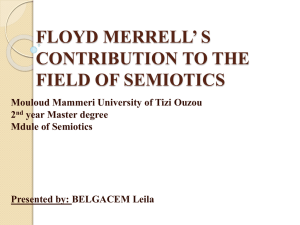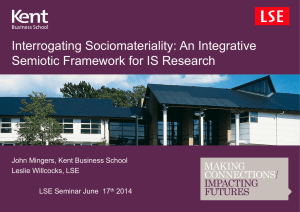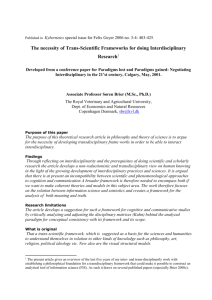Michael Shapiro publications on Peircean linguistics
advertisement
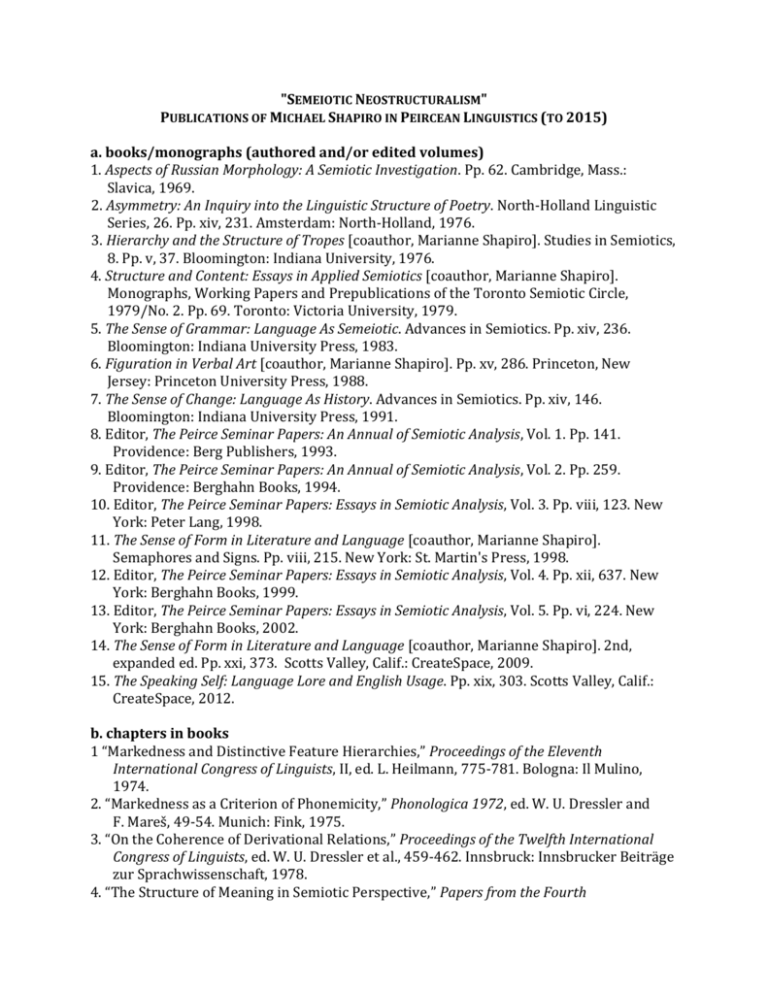
"SEMEIOTIC NEOSTRUCTURALISM" PUBLICATIONS OF MICHAEL SHAPIRO IN PEIRCEAN LINGUISTICS (TO 2015) a. books/monographs (authored and/or edited volumes) 1. Aspects of Russian Morphology: A Semiotic Investigation. Pp. 62. Cambridge, Mass.: Slavica, 1969. 2. Asymmetry: An Inquiry into the Linguistic Structure of Poetry. North-Holland Linguistic Series, 26. Pp. xiv, 231. Amsterdam: North-Holland, 1976. 3. Hierarchy and the Structure of Tropes [coauthor, Marianne Shapiro]. Studies in Semiotics, 8. Pp. v, 37. Bloomington: Indiana University, 1976. 4. Structure and Content: Essays in Applied Semiotics [coauthor, Marianne Shapiro]. Monographs, Working Papers and Prepublications of the Toronto Semiotic Circle, 1979/No. 2. Pp. 69. Toronto: Victoria University, 1979. 5. The Sense of Grammar: Language As Semeiotic. Advances in Semiotics. Pp. xiv, 236. Bloomington: Indiana University Press, 1983. 6. Figuration in Verbal Art [coauthor, Marianne Shapiro]. Pp. xv, 286. Princeton, New Jersey: Princeton University Press, 1988. 7. The Sense of Change: Language As History. Advances in Semiotics. Pp. xiv, 146. Bloomington: Indiana University Press, 1991. 8. Editor, The Peirce Seminar Papers: An Annual of Semiotic Analysis, Vol. 1. Pp. 141. Providence: Berg Publishers, 1993. 9. Editor, The Peirce Seminar Papers: An Annual of Semiotic Analysis, Vol. 2. Pp. 259. Providence: Berghahn Books, 1994. 10. Editor, The Peirce Seminar Papers: Essays in Semiotic Analysis, Vol. 3. Pp. viii, 123. New York: Peter Lang, 1998. 11. The Sense of Form in Literature and Language [coauthor, Marianne Shapiro]. Semaphores and Signs. Pp. viii, 215. New York: St. Martin's Press, 1998. 12. Editor, The Peirce Seminar Papers: Essays in Semiotic Analysis, Vol. 4. Pp. xii, 637. New York: Berghahn Books, 1999. 13. Editor, The Peirce Seminar Papers: Essays in Semiotic Analysis, Vol. 5. Pp. vi, 224. New York: Berghahn Books, 2002. 14. The Sense of Form in Literature and Language [coauthor, Marianne Shapiro]. 2nd, expanded ed. Pp. xxi, 373. Scotts Valley, Calif.: CreateSpace, 2009. 15. The Speaking Self: Language Lore and English Usage. Pp. xix, 303. Scotts Valley, Calif.: CreateSpace, 2012. b. chapters in books 1 “Markedness and Distinctive Feature Hierarchies,” Proceedings of the Eleventh International Congress of Linguists, II, ed. L. Heilmann, 775-781. Bologna: Il Mulino, 1974. 2. “Markedness as a Criterion of Phonemicity,” Phonologica 1972, ed. W. U. Dressler and F. Mareš, 49-54. Munich: Fink, 1975. 3. “On the Coherence of Derivational Relations,” Proceedings of the Twelfth International Congress of Linguists, ed. W. U. Dressler et al., 459-462. Innsbruck: Innsbrucker Beiträge zur Sprachwissenschaft, 1978. 4. “The Structure of Meaning in Semiotic Perspective,” Papers from the Fourth Michael Shapiro – Publications to 2015 2 International Conference on Historical Linguistics, ed. E. C. Traugott et al., 53-59. Amsterdam: Benjamins, 1980. 5.”Peirce's Interpretant from the Perspective of Linguistic Theory,” Proceedings of the C. S. Peirce Bicentennial International Congress (Graduate Studies, Texas Tech University, 23), ed. K. L. Ketner et al., 313-318. Lubbock: Texas Tech Press, 1981. 6. “Semiosis and (Poetic) Value,” Axia: Davis Symposium on Literary Evaluation (Stuttgarter Arbeiten zur Germanistik, 94), ed. K. Menges and D. Rancour- Laferriere, 51-60. Stuttgart: Akademischer Verlag, 1981. 7. “Dois paralogismos da poética,” O discurso da poesia [The Discourse of Poetry], 69-94. Coimbra: Livraria Almedian, 1982 [Portuguese translation of #c. 6] 8. “Remarks on the Nature of the Autotelic Sign,” Georgetown University Roundtable on Languages and Linguistics 1982, ed. H. Byrnes, 101-111. Washington, D.C.: Georgetown University Press, 1982. 9. “The Evaluative Component in a Theory of Poetic Language,” Russian Poetics (UCLA Slavic Studies, 4), ed. T. Eekman and D. S. Worth, 353-369. Columbus, Ohio: Slavica, 1983. 10. “The Meaning of Meter,” Russian Verse Theory (UCLA Slavic Studies, 18), ed. B. Scherr and D. S. Worth, 331-349. Columbus, Ohio: Slavica, 1989. 11. “On a Universal Criterion of Rule Coherence,” Contemporary Morphology, ed. W. Dressler et al., 25-34. Berlin: Mouton de Gruyter, 1990. 12. “Drift as an Organic Outcome of Type,” Historical Linguistics 1989. Papers from the 9th International Conference on Historical Linguistics (Current Issues in Linguistic Theory, 106), ed. H. Aertsen and R. J. Jeffers, 449-456. Amsterdam: Benjamins, 1993. 13. “History As Theory: One Linguist's View,” Peirce and Contemporary Thought: Philosophical Inquiries, ed. K. L. Ketner, 304-311. New York: Fordham University Press, 1995. 14. “A Few Remarks on Jakobson as a Student of Peirce,” The Peirce Seminar Papers, 3 (1998), 1-10. 15. “Markedness, Causation, and Linguistic Change: A Semiotic Perspective,” Actualization: Linguistic Change in Progress, ed. H. Andersen, 187-202. Amsterdam: Benjamins, 2001. 16. “Aspects of a Neo-Peircean Linguistics: Language History as Linguistic Theory,” The Peirce Seminar Papers, 5 (2002), 108-125. 17. “Sapir's Concept of Drift in Semiotic Perspective,” Edward Sapir: Critical Assessments of Leading Linguists, ed. E. F. K. Koerner, II, 107-119. London: Routledge, 2007 [rpt. of #c. 16]. 18. "Paradox: Theme and Semiotic Variations," Semiotics 2014: The Semiotics of Paradox (SSA Yearbook, 2), ed. J. Pelkey et al., 1-28. Ottawa: Legas, 2015. c. refereed journal articles 1. “Explorations into Markedness,” Language, 48 (1972), 343-364. 2. “Tenues and Mediae in Japanese: A Reinterpretation,” Papers in Japanese Linguistics, 2 (1973), 48-65. 3. “Morphophonemics as Semiotic,” Acta Linguistica Hafniensia, 15 (1974), 29-49. 4. “Tenues and Mediae in Japanese: A Reinterpretation,” Lingua, 33 (1974), 101-114 [revised version of #c.2]. Michael Shapiro – Publications to 2015 5. “Alternative Feature Ranking As a Source of Phonological Change,” Scando- Slavica, 20 (1974), 117-128. 6. “Sémiotique de la rime” [“The Semiotics of Rhyme”], Poétique, 20 (1974), 501-519. 7. “Deux paralogismes de la poétique” [“Two Paralogisms of Poetics”], Poétique, 28 (1976), 423-439. 8. “Toward a Global Theory of Style (A Peircean Exposé),” Ars Semeiotica, 3 (1980), 141147. 9. “Russian Conjugation: Theory and Hermeneutic,” Language, 56 (1980), 67-93. 10. “Poetry and Language, 'Considered As Semeiotic',” Transactions of the Charles S. Peirce Society, 16 (1980), 97-117. 11. “Signs, Marks, and Diacritics,” International Journal of Slavic Linguistics and Poetics, 31/32 (1985), 375-384. 12. “Teleology, Semeiosis, and Linguistic Change,” Diachronica, 2 (1985), 1-34. 13. “The Russian System of Stress,” Russian Linguistics, 10 (1986), 183-204. 14. “Style as Figuration,” Stanford Literature Review, 3 (1986), 195-211. 16. “Sapir's Concept of Drift in Semiotic Perspective,” Semiotica, 67 (1987), 159-171. 17. “Dynamic Interpretants and Grammar,” Transactions of the Charles S. Peirce Society, 24 (1988), 123-130. 18. “Presidential Address: The Boundary Question,” The American Journal of Semiotics, 10 (1993), 5-26. 19. “A Case of Distant Assimilation: /str/ /∫tr/,”American Speech, 70 (1995), 101- 107. 20. “Structural Analogies and the Sign Function in Dostoevsky,” Elementa, 2 (1995), 131146. 21. “Broad and Flat A in Marked Words,” American Speech , 72 (1997), 437-439. 22. “The Change of Government of commit ‘pledge/bind oneself’,”American Speech, 74 (1999), 333-336. 23. “The Clitic -uva (< of a),” American Speech, 76 (2001), 219-221. 24. “The Reduplicative Copula IS IS [co-author, Michael C. Haley],” American Speech, 77 (2002), 305-312. 25. “Is an Icon Iconic?,” Language, 84 (2008), 815-819. d. non-refereed journal articles 1. “Observations on the Russian Case System,” Linguistics, 69 (1971), 81-86. 2. “Markedness and Russian Stress,” Linguistics, 72 (1971), 61-77. 3
